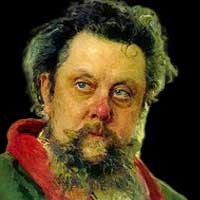Modest Mussorgsky Biography - A Very Quick Guide
Artist:
Modest Mussorgsky
Born:
1839, Karevo, Pskov
Died:
1881, Pskov
Who Was Modest Mussorgsky?
Modest Mussorgsky (1839–1881) was a Russian composer and a leading member of the “Mighty Handful,” a group committed to creating a distinctly Russian style of classical music. His work is known for its unconventional harmonies, direct emotional expression, and interest in realistic speech patterns. Though many of his pieces were left incomplete or later revised by others, Mussorgsky is now considered one of the most original composers of the 19th century.
What Is Mussorgsky Most Famous For?
Mussorgsky is best known for several works that have become staples of the classical repertoire:
Pictures at an Exhibition (1874), originally for piano, often performed in Ravel’s orchestration.
Night on Bald Mountain, a tone poem depicting a witches’ Sabbath.
Boris Godunov (1869/1872), an opera notable for its realistic vocal writing and portrayal of historical events.
Khovanshchina, another major opera completed after his death.
He also wrote important song cycles, including Songs and Dances of Death and The Nursery.
What Inspired Mussorgsky’s Music?
Mussorgsky aimed to reflect real-life speech, behavior, and social situations in his compositions. He was influenced by:
Russian folk music and storytelling
The natural rhythms of spoken Russian
National history and folklore
Realism in literature and theatre
His friendships with artists such as Viktor Hartmann, whose exhibition inspired Pictures at an Exhibition
This approach led him to use irregular phrasing, unconventional harmony, and a focus on character-driven writing.
When Was Mussorgsky Born?
He was born on March 21, 1839 (March 9 in the Old Style calendar), on his family’s estate in Karevo, in the Pskov region of Russia. He received an early musical education from his mother and later studied piano and composition in St. Petersburg.
How Did Modest Mussorgsky Die?
Mussorgsky died on March 28, 1881, at the age of 42, in St. Petersburg. His death was caused by complications related to chronic alcoholism. In the final years of his life, his health had been unstable, and he lost several positions due to his drinking.
10 Facts About Modest Mussorgsky
Modest Mussorgsky (1839–1881) was a Russian composer and a leading member of the “Mighty Handful,” a group committed to creating a distinctly Russian style of classical music. His work is known for its unconventional harmonies, direct emotional expression, and interest in realistic speech patterns. Though many of his pieces were left incomplete or later revised by others, Mussorgsky is now considered one of the most original composers of the 19th century.
What Is Mussorgsky Most Famous For?
Mussorgsky is best known for several works that have become staples of the classical repertoire:
Pictures at an Exhibition (1874), originally for piano, often performed in Ravel’s orchestration.
Night on Bald Mountain, a tone poem depicting a witches’ Sabbath.
Boris Godunov (1869/1872), an opera notable for its realistic vocal writing and portrayal of historical events.
Khovanshchina, another major opera completed after his death.
He also wrote important song cycles, including Songs and Dances of Death and The Nursery.
What Inspired Mussorgsky’s Music?
Mussorgsky aimed to reflect real-life speech, behavior, and social situations in his compositions. He was influenced by:
When Was Mussorgsky Born?
He was born on March 21, 1839 (March 9 in the Old Style calendar), on his family’s estate in Karevo, in the Pskov region of Russia. He received an early musical education from his mother and later studied piano and composition in St. Petersburg.
How Did Modest Mussorgsky Die?
Mussorgsky died on March 28, 1881, at the age of 42, in St. Petersburg. His death was caused by complications related to chronic alcoholism. In the final years of his life, his health had been unstable, and he lost several positions due to his drinking.
10 Facts About Modest Mussorgsky
- He served briefly as an officer in the Imperial Guard before leaving the military to pursue music.
- He worked various government jobs throughout his life to support himself.
- He was largely self-taught in composition after early lessons with Balakirev.
- Rimsky-Korsakov revised many of his works after his death to “correct” their harmony and orchestration.
- Pictures at an Exhibition was written in just a few weeks following Hartmann’s sudden death.
- Boris Godunov exists in multiple versions due to censorship and Mussorgsky’s own revisions.
- His music was often criticized in his lifetime for being crude or unfinished.
- He lived for several years in a shared apartment with other artists and musicians, a lively creative environment but financially unstable.
- Many of his manuscripts were left incomplete and had to be edited or orchestrated by colleagues.
- Today he is recognized as a pioneer of musical realism and an important influence on later Russian composers such as Shostakovich.
Top Pieces on 8notes by Modest Mussorgsky
Promenade from Pictures at an Exhibition
Pictures at an Exhibition No.3 - Tuleries
Pictures at an Exhibition No.3 - Tuleries
Pictures at an Exhibition No.10 - The Great Gate of Kiev
Pictures at an Exhibition No.5 - Ballet of the chicks still in their shells
Promenade from Pictures at an Exhibition
Gopak
Promenade from Pictures at an Exhibition
Night on the Bare Mountain
Pictures at an Exhibition No.3 - Tuleries
Pictures at an Exhibition No.3 - Tuleries
Pictures at an Exhibition No.10 - The Great Gate of Kiev
Pictures at an Exhibition No.5 - Ballet of the chicks still in their shells
Promenade from Pictures at an Exhibition
Gopak
Promenade from Pictures at an Exhibition
Night on the Bare Mountain
